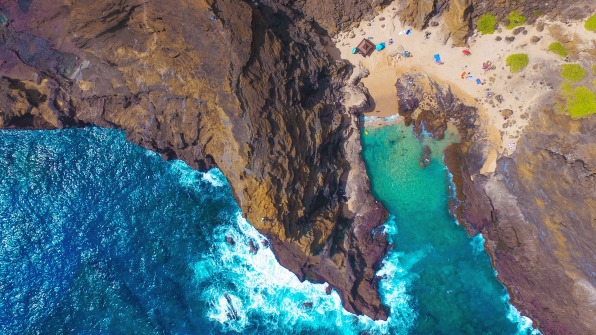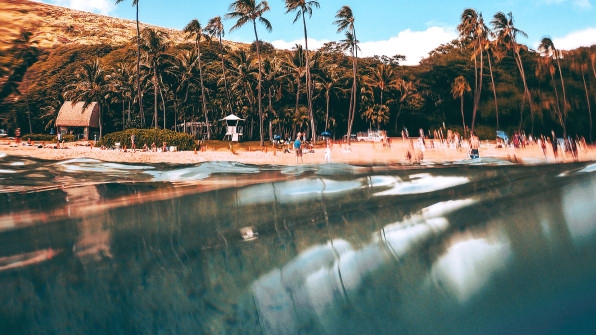Hawaii just passed a law to make the state carbon neutral by 2045
In a little less than three decades, Hawaii plans to be carbon neutral–the most ambitious climate goal in the United States. Governor David Ige signed a bill today committing to make the state fully carbon neutral by 2045, along with a second bill that will use carbon offsets to help fund planting trees throughout Hawaii. A third bill requires new building projects to consider how high sea levels will rise in their engineering decisions.
The state is especially vulnerable to climate change–sea level rise, for example, threatens to cause $19 billion in economic losses–and that’s one of the reasons that the new laws had support. “We’re on the forefront of climate change impacts,” says Scott Glenn, who leads the state’s environmental quality office. “We experience it directly and we’re a small island. People feel the trade wind days becoming less. They notice the changes in rain. They feel it getting hotter. Because we are directly exposed to this, there’s no denying it.” The state’s political leaders, he says, are “unified in acknowledging that climate change is real and that we do need to do something about it.”

Hawaii is already a leader on climate. In 2015, the state passed a law to move to 100% renewable electricity by 2045 (shifting to renewables also helps save money on electric bills, since Hawaii has to import fossil fuels from elsewhere, and it also helps make the island more resilient to disasters). In 2017, days after Trump announced that the U.S. would pull out of the Paris climate agreement, the state passed another law to uphold the agreement’s goal to limit global warming to less than 2 degrees Celsius.
Transportation is a challenge–while the state is planning for a future where cars run on renewable electricity, it also relies heavily on planes and ships, which will take longer to move to electric charging, and which Hawaii can’t directly control. “Those are global transportation networks that don’t have easy substitutes right now,” Glenn says.
“That’s one of the reasons why we really want to pursue the carbon offset program, because we know we’re going to continue to be dependent on shipping and aviation, and if they continue to burn carbon to bring us our tourists and our goods and our supplies and our food, then we want to try to have a way to sequester the impact we’re causing by importing all this stuff to our islands.” The government plans to sell carbon offsets to pay to plant native trees, which can help absorb CO2 from the atmosphere as they grow.
The state is also working to become more self-sufficient. The governor aims to double local food production by 2020; right now, around 90% of what residents and tourists eat in Hawaii–6 million pounds of food a day–comes from somewhere else, on planes or ships.
Before Hawaii set its goal of carbon neutrality by 2045–meaning that it will sequester more carbon from the atmosphere than the emissions it produces–Rhode Island had the most ambitious goal to cut emissions of any state, with a goal to reduce emissions 85% below 1990 levels by 2050. But several countries also have goals to become completely carbon neutral.

The Maldives is working to become carbon neutral by 2020. Costa Rica will follow in 2021. Norway will be carbon neutral by 2030, Iceland will reach that goal by 2040, and Sweden by 2045. France and New Zealand plan to be carbon neutral by 2050. Some cities are also pursuing the goal. Copenhagen, for example, aims to be carbon neutral by 2025, and Oslo will follow in 2030. Austin, Boston, and several others plan to be carbon neutral by 2050.
In the U.S., as Hawaii moves forward on climate action, it can grow as a testing ground for sustainable technology. “There’s a lot of innovation and research happening across the Hawaii island right now,” says Glenn. Each island has a standalone electric grid, unlike the mainland U.S., where everything is connected. The grids are also different sizes, and use different types of renewable energy, making the state a useful place for companies to see how tech works in different conditions.
As Hawaii learns from other states, it can also share knowledge and inspire more action. “We’re small,” Glenn says. “We’re a rounding error to the emissions that California has…But [others] say, if Hawaii can do it, we can do it. If an island in the middle of the Pacific can make this happen, then we can make it happen. That’s what we try to do. That’s the role we see ourselves having within our national dialogue.”
Correction: This article has been updated to reflect that Hawaii’s has committed to doubling local food production by 2020.
(23)



